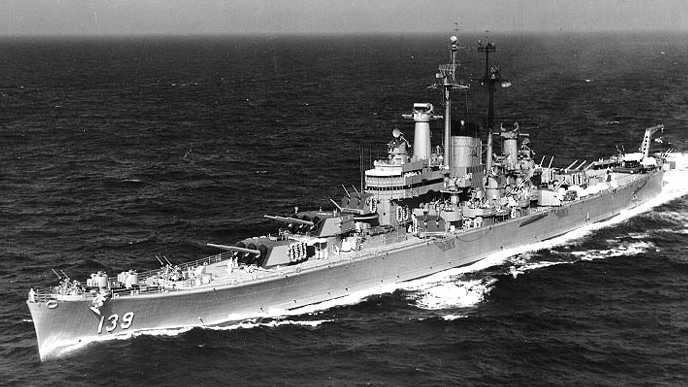
These were the first USN 8" (20.3 cm) guns to use separate rather than bag ammunition. With automatic shell handling and loading, a fire rate three times greater than that of previous 8" (20.3 cm) guns and coupled together with the use of "super-heavy" AP projectiles, these weapons made the Des Moines (CA-134) class the most powerful heavy cruisers ever built. One of the few large-caliber automatic gun designs that proved reliable in actual service use, these weapons were still giving good performance during the Vietnam War, some twenty-five years after they first entered service. Unfortunately, all this performance came at a steep price in weight, with the turrets mountings for these guns weighing 50% more than those in the previous Baltimore class.
During a fire mission off Vietnam in October 1972, USS Newport News (CA-148) suffered a premature projectile explosion in the center gun of Turret II that killed twenty crewmen. The projectile explosion was caused by a faulty auxiliary detonating fuze and this ignited a further nine cartridges in the ammunition hoists. The explosion caused extensive damage to the mounting and split the forward slide structure. Up until about six months prior to the explosion there had been a complete spare gun assembly in the supply system, but it had then been scraped because the Navy felt that it cost too much to let it sit in a warehouse. It was proposed to replace the damaged mounting with one taken from her decommissioned sisters, but this was rejected as being too expensive. As a result, the damage was not repaired and the turret was simply closed off.
These weapons were apparently the first loose-liner guns in service in the USN. Mark 16 Mod 0 was constructed of a monobloc autofretted barrel with a chrome-plated loose-liner held by a liner-locking ring. The barrel screwed into the housing which contained the breech block. Used a wedge-type vertical sliding breech block in place of the conventional interrupted screw. Unlike previous US 8" (20.3 cm) guns, these guns could load at any angle. An air bottle supplied pneumatic power to open and close the sliding breech block system used in these ships.
There was a Mark 16 Mod 1 bag gun. It is not clear if any of these were ever built.
| Designation | 8"/55RF (20.3 cm) Mark 16 |
|---|---|
| Ship Class Used On | Des Moines (CA-134) class |
| Date Of Design | 1943 |
| Date In Service | 1948 |
| Gun Weight | 17.14 tons (17.4 mt) 1 |
| Gun Length oa | about 449.0 in (11.405 m) 2 |
| Bore Length | 440.1 in (11.179 m) |
| Rifling Length | 383.5 in (9.741 m) |
| Grooves | (64) 0.070 in (1.78 mm) deep |
| Lands | N/A |
| Twist | Uniform RH 1 in 25 |
| Chamber Volume | 3,367 in3 (55.2 dm3) |
| Rate Of Fire | 10 rounds per minute 3 |
- ^The weight including the slide was much greater than indicated above, as the oscillating weight per gun was 51.6 tons (52.4 mt) compared with 29.0 tons (29.5 mt) for the Mark 12 and Mark 15.
- ^The overall length from the muzzle to the rammer at the rear of the slide was 588.5 in (14.948 m).
- ^BuOrd was particularly - and justifiably - proud of this design. The high ROF figure was routinely and reliably achieved by all three ships of this class. Commented BuShips engineer E.A. Wright after viewing a demonstration bombardment by USS Newport News on 07 September 1949: "The automatic ammunition supply and loading worked perfectly and at the designed rate, which still seems to me phenomenal for that caliber."
| Type | Separate |
|---|---|
| Projectile Types and Weights | AP Mark 21 Mods 1 to 5 (super heavy) 1a: 335 lbs. (152 kg)
SP Common Mark 17 Mods 1 to 4 2a: 260 lbs. (118 kg) HC Mark 24 Mods 1 to 5 3a: 260 lbs. (118 kg) HC Mark 25 Mod 1 3a 4a: 260 lbs. (118 kg) |
| Bursting Charge | AP Mark 21: 5.03 lbs. (2.3 kg) Explosive D
SP Common: 10.38 lbs. (4.7 kg) Explosive D HC Mark 24: 21.34 lbs. (9.7 kg) Explosive D HC Mark 25: 21.37 lbs. (9.7 kg) Explosive D |
| Projectile Length | AP Mark 19: 36.0 in (91.4 cm)
SP Common: 36.0 in (91.4 cm) HC Mark 24: 34.56 in (87.8 cm) HC Mark 25: 34.61 in (87.9 cm) |
| Cartridge Case Type, Size and Empty Weight 5a | Mark 1: Brass, 203 x 1,277 mm, 57.0 lbs. (25.9 kg)
Mark 2: Brass, 203 x 789 mm, N/A |
| Propellant Charge | Full Charge: 77 lbs (34.9 kg) SPD or SPDN
Full Flashless Charge: 82 lbs. (37.2 kg) SPCG Reduced Charge: 45 lbs. (20.4 kg) SPDN
|
| Muzzle Velocity | Full Charge: New Gun
AP: 2,500 fps (762 mps) HC: 2,700 fps (823 mps) Reduced Charge: New Gun
|
| Working Pressure | 18.2 tons/in2 (2,870 kg/cm2) |
| Approximate Barrel Life | 780 rounds |
| Magazine capacity per gun | 150 rounds |
- ^Other than the Des Moines (CA-134) class, AP Mark 21 (super heavy) was apparently issued only to the Baltimore (CA-68) and Oregon City (CA-122) classes.
- ^SP Common had a thin cap and a windscreen.
- ^HC Mark 25 was designed such that it could be forged from the base end.
- ^Mark 1 cartridge case was for full charges while the Mark 2 was a short case for reduced charges.
- Unlike other USN semi-fixed ammunition, the cork plug sealing the cartridge case for this weapon was mounted flush with the end of the cartridge. The mouth of the cartridge was "cone crimped" or necked down to about the same diameter as the base of the projectiles. This heavy cone crimp allowed the weight of the projectile to be carried by the case itself rather than by the plug as they were rammed into the breech.
| Elevation | Range | Angle of Fall | Time of Flight | Striking Velocity | Maximum Ordinate |
|---|---|---|---|---|---|
| 1.95 degrees | 4,000 yards (3,658 m) | 2.15 degrees | 5.17 seconds | 2,156 fps (657 mps) | 107 ft (33 m) |
| 5.81 degrees | 10,000 yards (9,140 m) | 7.52 degrees | 14.65 seconds | 1,248 fps (380 mps) | 862 ft (263 m) |
| 10.28 degrees | 15,000 yards (13,716 m) | 14.95 degrees | 24.70 seconds | 1,415 fps (431 mps) | 2,465 ft (751 m) |
| 16.45 degrees | 20,000 yards (18,290 m) | 25.73 degrees | 32.77 seconds | 1,248 fps (380 mps) | 5,650 ft (1,722 m) |
| 23.17 degrees | 24,000 yards (21,946 m) | 36.10 degrees | 49.56 seconds | 1,211 fps (369 mps) | 10,070 ft (3,069 m) |
| 40.72 degrees | 30,000 yards (27,430 m) | 54.45 degrees | 77.79 seconds | 1,294 fps (394 mps) | 24,770 ft (7,550 m) |
| 45.28 degrees | 30,500 yards (27,889 m) | 57.73 degrees | 84.15 seconds | 1,325 fps (404 mps) | 28,880 ft (8,803 m) |
- ^Values for AP Mark 21 from BuOrd OP 1100 and from "Naval Ordnance and Gunnery, Volume 2, Fire Control - 1950."
| Elevation | Range | Angle of Fall | Time of Flight | Striking Velocity | Maximum Ordinate |
|---|---|---|---|---|---|
| 1.71 degrees | 4,000 yards (3,658 m) | 1.92 degrees | 4.86 seconds | 2,267 fps (691 mps) | 95 ft (29 m) |
| 5.22 degrees | 10,000 yards (9,140 m) | 7.03 degrees | 14.03 seconds | 1,724 fps (525 mps) | 795 ft (242 m) |
| 10.55 degrees | 16,000 yards (14,630 m) | 16.80 degrees | 20.41 seconds | 1,340 fps (408 mps) | 2,834 ft (864 m) |
| 14.64 degrees | 20,000 yards (18,290 m) | 26.43 degrees | 36.91 seconds | 1,197 fps (365 mps) | 5,600 ft (1,707 m) |
| 22.40 degrees | 24,000 yards (21,946 m) | 37.43 degrees | 49.46 seconds | 1,165 fps (355 mps) | 10,130 ft (3,088 m) |
| 39.03 degrees | 30,000 yards (27,430 m) | 55.00 degrees | 76.88 seconds | 1,250 fps (381 mps) | 24,455 ft (7,454 m) |
| 41.92 degrees | 30,500 yards (27,889 m) | 57.25 degrees | 81.18 seconds | 1,268 fps (386 mps) | 26,950 ft (8,214 m) |
- ^Values for SP Common Mark 17 from BuOrd OP 1188 page 30.
| Elevation | Range | Angle of Fall | Time of Flight | Striking Velocity | Maximum Ordinate |
|---|---|---|---|---|---|
| 1.70 degrees | 4,000 yards (3,658 m) | 1.90 degrees | 4.84 seconds | 2,273 fps (693 mps) | 94 ft (29 m) |
| 3.88 degrees | 8,000 yards (7,315 m) | 4.98 degrees | 10.68 seconds | 1,868 fps (569 mps) | 458 ft (140 m) |
| 5.23 degrees | 10,000 yards (9,144 m) | 7.20 degrees | 14.09 seconds | 1,686 fps (514 mps) | 799 ft (244 m) |
| 6.79 degrees | 12,000 yards (10,973 m) | 9.97 degrees | 17.90 seconds | 1,521 fps (463 mps) | 1,290 ft (393 m) |
| 10.75 degrees | 16,000 yards (14,630 m) | 17.83 degrees | 26.93 seconds | 1,376 fps (419 mps) | 2,926 ft (892 m) |
| 16.20 degrees | 20,000 yards (18,288 m) | 28.78 degrees | 38.13 seconds | 1,120 fps (341 mps) | 5,913 ft (1,802 m) |
| 19.62 degrees | 22,000 yards (20,117 m) | 34.82 degrees | 44.57 seconds | 1,107 fps (337 mps) | 8,136 ft (2,480 m) |
| 28.22 degrees | 26,000 yards (23,774 m) | 46.58 degrees | 59.52 seconds | 1,131 fps (345 mps) | 14,676 ft (4,473 m) |
| 42.10 degrees | 30,000 yards (27,432 m) | 58.77 degrees | 81.63 seconds | 1,203 fps (367 mps) | 27,227 ft (8,299 m) |
| 45.00 degrees | 30,360 yards (27,761 m) | 60.70 degrees | 85.92 seconds | 1,221 fps (372 mps) | 30,028 ft (9,153 m) |
- ^Values for HC Marks 24 and 25 from BuOrd OP 1188 page 34.
| Range | Side Armor | Deck Armor |
|---|---|---|
| 10,800 yards (9,880 m) | 10.0" (254 mm) | --- |
| 15,400 yards (14,080 m) | 8.0" (203 mm) | --- |
| 18,400 yards (16,820 m) | --- | 2.0" (51 mm) |
| 20,800 yards (19,020 m) | 6.0" (152 mm) | --- |
| 23,800 yards (21,760 m) | --- | 3.0" (76 mm) |
| 24,400 yards (22,310 m) | 5.0" (127 mm) | --- |
| 27,600 yards (25,240 m) | --- | 4.0" (102 mm) |
| 28,600 yards (26,150 m) | 4.0" (102 mm) | --- |
- These figures are taken from armor penetration curves issued in 1942 as shown in "US Naval Weapons."
| Designation | Three-gun Turrets 1f Des Moines (3) |
|---|---|
| Weight | 451 tons (458 mt) |
| Elevation | -5 / +41 degrees |
| Elevation Rate | 8.2 degrees per second |
| Train | +150 / -150 degrees |
| Train Rate | 5 degrees per second |
| Gun recoil | 28 in (71 cm) 2f |
| Loading angle | Any angle |
- ^It had been planned to replace No. 3 14" (35.6 cm) Turret on USS Mississippi (AG-128) with a three-gun 8" (20.3 cm) RF turret, but this did not take place.
- ^This is the nominal figure. The maximum, metal-to-metal recoil length was 29 in (73.7 cm).
- The barbette design for these ships was cylindrical, not cone-shaped as in the previous Baltimore, Oregon City and Wichita classes.
- From "Naval Weapons of World War Two" by John Campbell: "Shells were stowed in the rotating structure on inner and outer live rings, both on two deck levels. The wing pusher hoists began between the inner and outer shell rings, while the center one was inside the inner ring starting on the axis. The shells were delivered to trays attached to arms pivoted on the cradle trunnions and thence to transfer trays which moved into position for ramming. The cartridges were similarly raised by three hoists from a deck level below the shells to pivoted trays and placed behind the shells. Shell and cartridge case were rammed together. After firing, the empty case was extracted and ejected by a chute running forward under the guns."
- This was the only major USN turret design where the guns were elevated by arc and pinion rather than the usual elevating screw and oscillating bearing. It was also the only major USN turret without an optical rangefinder, with two radars on each turret being used in their place.
- This mounting used a 125 hp training motor and each gun was elevated by a 25 hp motor. The rammers were powered by three 35 hp motors, the shell hoists by three 20 hp motors, the cartridge hoists by three 15 hp motors and each of the four live rings used a 20 hp motors. All of these motors drove hydraulic gear.
- The gun axes were 85 in (216 cm) apart.
- Each mounting requires a crew of about 44 to operate, a reduction of about 33 percent from earlier mountings.
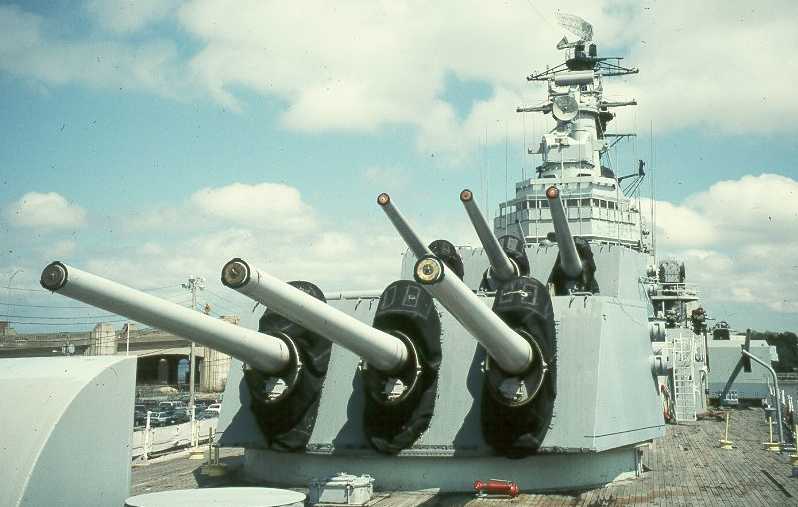
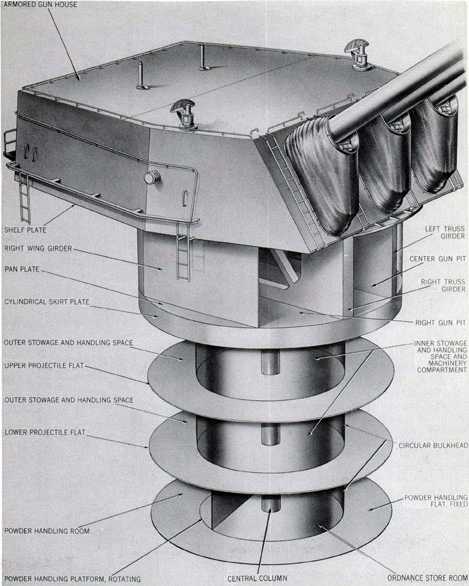
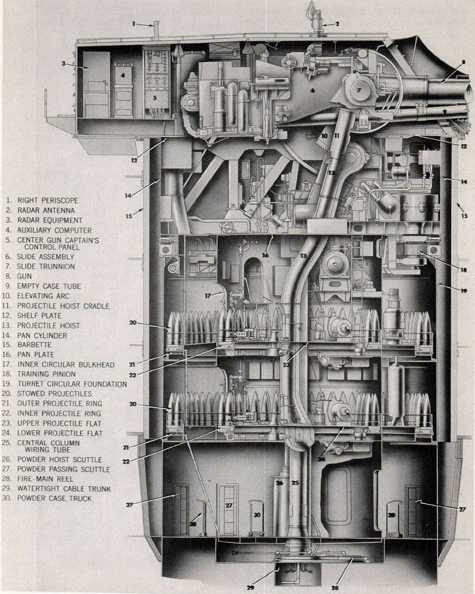
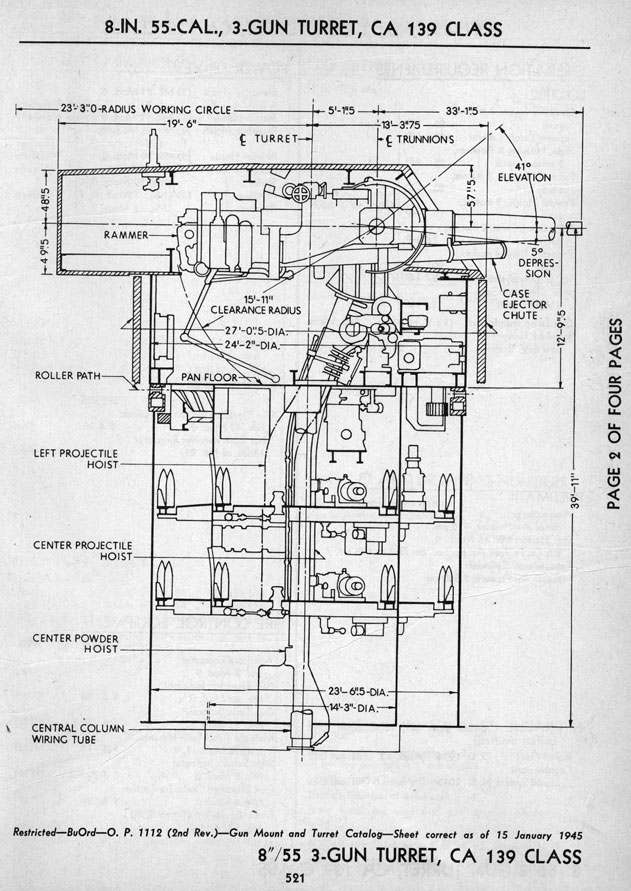
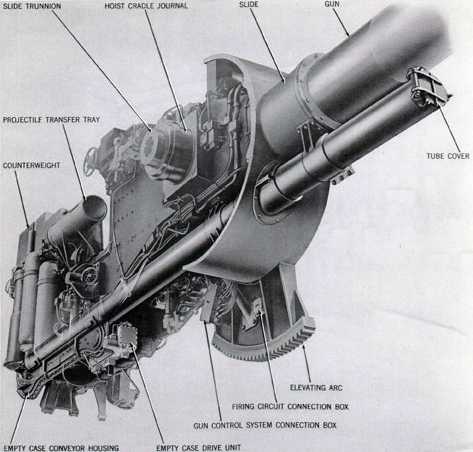
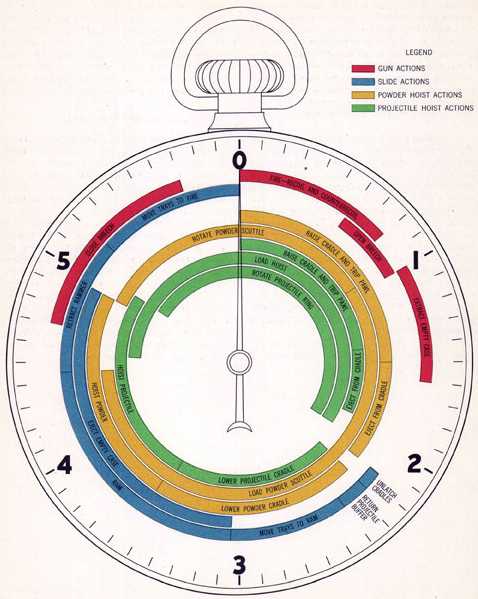
"Naval Weapons of World War Two" by John Campbell
"US Naval Weapons", "US Cruisers: An Illustrated Design History" and "The Naval Institute Guide to World Naval Weapon Systems 1991/92" all by Norman Friedman
"U.S. Navy Bureau of Ordnance in World War II" by Lt. Cmdr. Buford Rowland, USNR, and Lt. William B. Boyd, USNR
"Cruisers of World War Two" by M.J. Whitley
---
"Abridged Range Tables for U.S. Naval Guns - Ordnance Pamphlet No. 1188 - 13 June 1944" by Bureau of Ordnance (BuOrd), Department of the Navy
"U.S. Explosive Ordnance - Ordnance Pamphlet No. 1664 - May 1947" by Bureau of Ordnance (BuOrd), Department of the Navy
---
Gene Slover's Navy Pages
---
Turret II Explosion Report from USS Newport News (CA-148) Website
Ordnance Pamphlet No. 1180, 8-Inch 3-Gun Turrets Main Armament For USS Salem Class, Turret Description And Operation, July 1947" at Historic Naval Ships Association
---
Special help from Leo Fischer
07 February 2008 - Benchmark
27 January 2011 - Corrected typographical error
13 June 2016 - Converted to HTML 5 format
30 September 2018 - Reorganized notes
24 December 2018 - Added turret sketch
27 November 2021 - Updated OP-1180 and Turret II Explosion links to point to Wayback Archive
04 August 2023 - Revised range tables
09 February 2025 - Added comment about planned used on USS Mississippi (AG-128)
